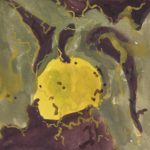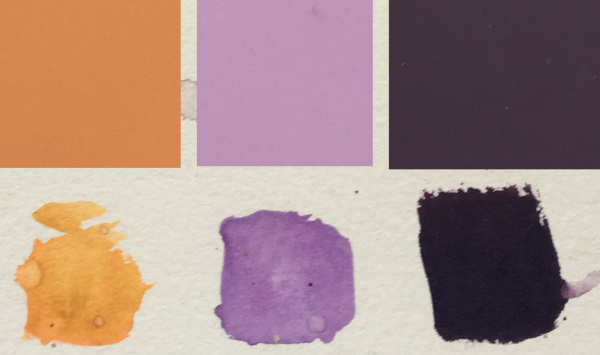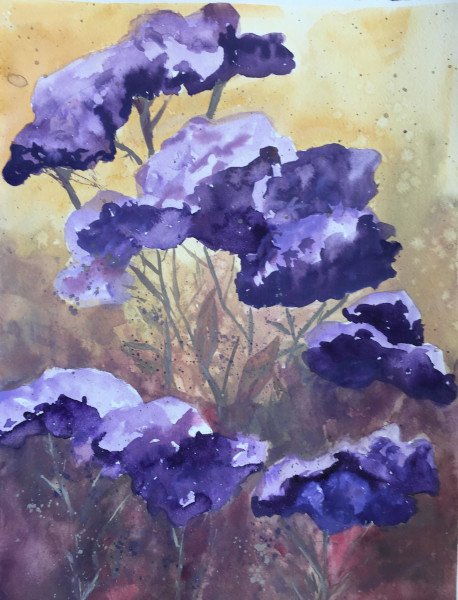As recently as a few months ago, I promised that there would be no more workshops for a couple of years so I could work on “my own voice.” I changed my mind (and Ruth Ellen Hoag says that’s okay.)
Loyal readers may remember I took a workshop from Ruth about three years ago. I had a good time and I learned a lot. But what was really important is that I felt supported to explore my own process.
Recently, I’ve been feeling a lot of desire to paint; unfortunately, whenever I sit down, the paintbrush does not do well in my hand. The sketches are great, but the paint application feels… wrong. It is unclear to me how much of this is that I have spent most of the summer and fall sketching and drawing, not painting, and how much is that in the last few weeks I have hit an intense “grief patch.” The other day, looking down at a failed painting, I decided that a workshop was the perfect “no fail” space to get painting again. And so I whipped out the credit card and committed.
Except for Ruth Buchanan, Ruth Ellen Hoag is the only workshop presenter I have repeated with. (Incidently, this workshop was organized by Ruth Armitage. What is it with me and Ruths?)
Ruth Ellen Hoag: Composition & Color for Contemporary Painters
In this workshop, Ruth Ellen Hoag will present a look at what today’s artists are doing to create unique works that capture the imagination.
How do we build technical skills in acrylic or watercolor, and then use these skills to our advantage? How do we find our own way in this contemporary art world to create what is unique to us? Are there rules for what makes good art? How do we develop a distinctive color palette?
Whether you work from an expressive mode, or see the world through a strong design perspective, you’ll find ideas for creating contemporary realism and non-objective abstraction in this workshop. Developing color sense and creative composition will be our focus.
Day 1: Color
After a quick introduction and lecture, Ruth started us off on the day 1 adventure: color. She presented an impressive collection of paint chips (like from your local hardware store) and said we could pick randomly or willfully. But the task was to mix the colors EXACTLY using as few tube colors as possible.
This was my random selection. The green took cadmium yellow, skip green, titanium white, and sepia. The purple/brown took sepia, quinacridone pink, and titanium white. The yellow took cadmium yellow, titanium white, and sepia.
Once we had the colors mixed, we were supposed to doodle.
There was another lecture, then we wandered of to develop full paintings from our color choices. One additional option was the ability to add three spots of accent color to bring a piece together, which I did in the painting below.
What would a workshop be without a “legs” piece?

Day 2: Composition
I was grooving on the challenge, so I choose another three random colors. This set was more than a little challenging.
Okay, so when in doubt, try a pear.
I added some of the techniques I learned in the Judy Hoiness breakout session a few weeks ago at the WSO convention.
There were some flowers outside the window.
Then I decided to try experimenting a little more with my recent “geometric” inspiration.
What I learned here (and it may be my biggest breakthrough) is that I need to stick to an idea… not al ideas.
And so this painting stayed with a simple idea.
Day 3: Style
On the third day, I deliberately chose my palette. I’ve been noticing that lately I’ve been liked a duller, more sophisticated palette. So, I thought it was the perfect day to try it.
With the theme of the day being style, I decided to stick with horses as it’s an ambition to be a horse painter. This reference photo called to me, the horse straining to move the load. But could I show that without using red (red=power)? And without any “horsey” colors.
I decided to try a geometric, spot color approach. Some areas are successful, other less so.
Seeing my draft and listening to my “no red” story, Ruth encouraged me to try it with “real colors” to see if the result was better.
As you can see, I exaggerated some of the angles. It is also less finished than the first. I think the “power” comes through more, but it will require some work to be really finished.
This piece had been sitting around the summer, drawn but not painted. So, I brought it to work on. After all, it wasn’t getting any better just sitting on my desk.
With some finishing, this has some possibilities. Maybe.
I also drew and prepped this piece, but I didn’t have time to apply more than a base layer.
Mottos
With all the painting, you might think there was no talking. But Ruth put together some nice lectures to help us move through the process. One of the reoccurring themes was studio mottos. Ruth shared another artist’s mottos (unfortunately, I have lost her name)
- Believe in what I’m creating
- Try anything… make mistakes
- If it’s ugly, gesso over it.
- Nobody died from using materials “the wrong way”
- Just try it.
Then Ruth shared her mottos, inspired by the above.
- Just paint the damn thing
- If it’s “expected,” don’t do it
- Choose colors carefully
- After all due contemplation, just start!
My assignment, now is to create my own mottos. When I think about my process, what mottos or quotes keep me on track? (Well, nothing really keeps me on track…)
Series
The issue of working in a series came up. This is a very trendy thing in the art world right now, but Ruth suggested an innovative approach: Create a worksheet and pin it up. Possible questions include:
- Content
- Form
- Title of Series
- Inspiration
- Goal
- Number of paintings
She also suggested keeping notes. How will you start? What did you learn after each painting?
I have committed to a solo show in just under five months. I think this might be something I will be using as this deadline is looming large!
Conclusion
This was money and time well spent. While I am still dealing with things, being in the “safe” environment of a workshop helped. The trick will be to get myself back in the studio while these ideas are still fresh.
I really enjoyed Ruth and I think she has developed over the last three years. I was worried that being a repeat workshop it would be the same ideas over again. It was not. While Ruth knew me a little bit from the last workshop, the emphasis was completely different and the pushes and nudges were appropriate for this time in my career.
As Ruth Armitage (I may have to start numbering them…) said at one point, we are all inching toward progress. This was the gentlest nudge in the right direction.


















Tara, thank you for all of the great information!
I enjoy your bits of humor dropped here and there.
Bonnie